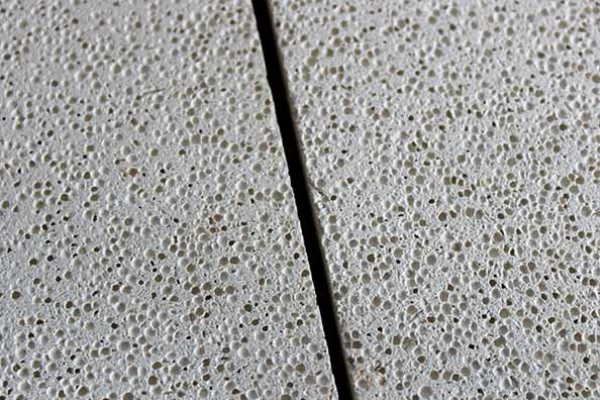
Corindon - mullite en même temps avec corindon et mullite deux excellentes performances.
La céramique poreuse est une sorte de matériau céramique qui se compose de nombreux pores disposés dans l'espace de différentes manières.
Les céramiques poreuses en fonction de la taille des pores peuvent être divisées en céramiques poreuses à grosse ouverture (diamètre des pores > 500µm) poreux à grande ouverture (500µm > diamètre des pores > 100µm), céramique poreuse dans l'ouverture (100µm > diamètre des pores > 10µm), céramique poreuse dans la petite ouverture (10µm > diamètre des pores > 1µm), céramique poreuse (diamètre des pores < 1µm).
La structure des pores de la céramique peut être divisée en céramiques poreuses de type à pores ouverts., céramiques à pores fermés, et céramiques poreuses pénétrantes. Les céramiques poreuses ont des pores uniformément répartis ou de nombreux pores pénétrants, à haute perméabilité. Il y a de nombreux pores dans la matrice, elle a donc une faible densité apparente.
Les céramiques poreuses développées avec des surfaces spécifiques peuvent produire des propriétés de surface physiques uniques et peuvent être formées sur la perméabilité sélective des milieux liquides et gazeux., tout en réduisant encore la conductivité thermique des céramiques.
À la fois, les matériaux céramiques ont une résistance unique aux hautes températures, résistance à la corrosion, haute stabilité chimique, et stabilité dimensionnelle, la céramique poreuse en tant que nouveau type de matériau s'est développée rapidement.
Actuellement, les céramiques poreuses sont utilisées dans les capteurs de gaz, supports de catalyseur, filtres pour gaz chauds ou métaux en fusion, et matériaux d'isolation réfractaires haute température. En tant que porteurs de catalyseurs, les céramiques poreuses présentent les avantages d'une résistance aux hautes températures, résistance à la corrosion, aucune contamination du catalyseur, et faible coût par rapport aux autres supports de catalyseur.
Briques réfractaires légères en mullite à la phase cristalline principale de mullite des matériaux réfractaires à haute teneur en alumine, teneur générale en alumine entre 65% -75%. Mullite lightweight refractory bricks’ refractory temperature can reach more than 1790 ℃. Température de démarrage du ramollissement de la charge de 1600-1700 ℃. Bonne résistance aux chocs thermiques.
Les briques de mullite poreuses légères ont une faible densité, grande surface spécifique, faible conductivité thermique et coefficient de dilatation thermique, point de fusion élevé, et bonne résistance à la corrosion, et ont une très large perspective d'application dans le domaine de l'isolation thermique à haute température, filtration, catalytique et ainsi de suite.
Briques de mullite faites de mullite comme matière première principale, avec une résistance à haute température, faible taux de fluage, faible dilatation thermique, forte résistance à l'érosion chimique, et bonne résistance aux chocs thermiques, etc., peut être utilisé pour la voûte du four à air chaud et la chambre de combustion au milieu et en haut, mais aussi pour les briques de brûleur en céramique.
Maintenant, les briques réfractaires de mullite de haute pureté sont utilisées dans divers revêtements de fours à haute température, y compris les fours à fournaise, hauts fourneaux, auges verseuses en fer chaud, et matériaux de revêtement de four de coulée continue.
Les briques de bain en étain à base de mullite sont un matériau réfractaire clé pour les fours à verre flottant au stade du moulage.
Corundum – mullite at the same time with corundum and mullite two excellent performances. C'est un matériau réfractaire de haute qualité résistant aux hautes températures, haute résistance mécanique, résistance au récurage, érosion, bonne résistance aux chocs thermiques, et un petit effet cloquant, qui est largement utilisé dans les fours à haute température.
La mullite-cordiérite est frittée avec de la mullite comme cordiérite globale comme matériau de base. Le coefficient de dilatation thermique du matériau de base en cordiérite est inférieur à celui de l'agrégat de mullite. En raison de l'inadéquation de leurs coefficients de dilatation, des microfissures se forment, la ténacité du matériau mullite-cordiérite est améliorée, et la stabilité thermique du mobilier du four à mullite-cordiérite est améliorée.
Les matériaux mullite-cordiérite ont une excellente résistance aux chocs thermiques et de bonnes performances à haute température et ont été couramment utilisés dans les meubles de fours à céramique par les fabricants nationaux et étrangers..
PER Réfractaires de nombreuses années d'expérience vous disent que. Avec sa légèreté et ses excellentes performances d’isolation thermique, Les briques réfractaires légères en mullite sont largement utilisées dans le revêtement réfractaire de surface chaude ou la couche d'isolation thermique de nombreux types d'équipements thermiques., ce qui crée les conditions nécessaires à l’amélioration de l’utilisation énergétique de l’équipement. Les briques réfractaires légères en mullite peuvent être utilisées comme revêtement réfractaire de surface chaude ou autre couche d'isolation de support réfractaire, utilisé dans le pétrole, industrie chimique, four de craquage d'éthylène, four de chauffage à tubes, convertisseurs d'ammoniac, fournaises à gaz, fours navettes à haute température, fours tunnel, four à rouleaux en céramique, Four à plaques poussoirs et autres fours industriels, matériaux d'isolation thermique, etc..
L'utilisation de différentes températures est principalement divisée en 1350 briques légères en mullite, 1450 briques isolantes en mullite, 1550 briques légères en mullite, et ainsi de suite.
Depuis octobre, les prix de l'alumine ont continué à augmenter, and China's largest bauxite importer - a…
D'abord, Brique à haute teneur en alumine: The Leader In High Temperature Refractories As a leader in high-temperature…
The application of refractory bricks in the kiln immediately endangers the operation rate of the…
Analysis Of The Causes Of Common Quality Problems In Tunnel Kiln Construction And Measures To…
Corundum quality refractory castables are made from corundum to the new jade refractory insulation material…
Analyse des matières premières réfractaires aluminium-silicium Prof. Li Yong of the University of Science and…